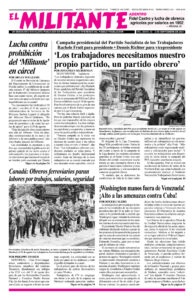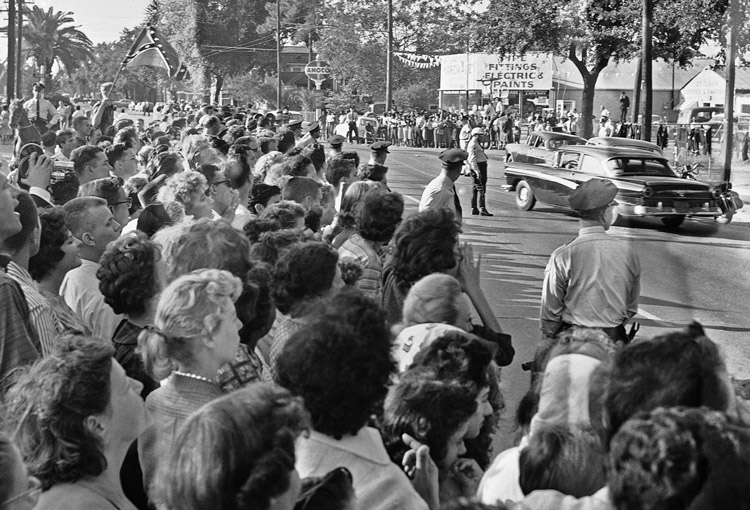ATLANTA — Tessie Prevost, one of four 6-year-old girls who faced down violent mobs to desegregate New Orleans schools, died July 6. Sixty-four years ago Prevost, along with Leona Tate and Gail Etienne, were escorted by federal marshals as they climbed the steps to enter the all-white McDonogh 19 school. That same day marshals led a fourth Black child, Ruby Bridges, into William Frantz Elementary School.
The school was named after John McDonogh, a slave owner and trader in the early 1800s, who amassed a great fortune. Living a contradiction, he left half of that fortune to the New Orleans school system, with the proviso that it be used to create schools “wherein the poor (and the poor only) of both sexes of all classes and castes of color shall have admittance.”
The girls’ ages, courage and discipline that day, and in the years that followed, is a window into the mass working-class social revolt that exploded in actions across the South in the late 1950s and early 1960s against all forms of Jim Crow.
Under a strict court order in 1960 the Orleans Parish School Board devised a plan for desegregation. It began with having 136 kindergarten-age Black children tested to see if they could “qualify” to be placed in an all-white school. Five students, all girls, met the exacting criteria. Only four took the challenge.
In several interviews the three girls assigned to McDonogh 19 described what unfolded that day, Nov. 14, 1960. Prevost said she knew something was very different because nobody was going to work. Her father was a postal worker and her mother a seamstress. They gathered for morning prayer before beginning the day.
Federal marshals arrived in a black sedan outside the girls’ homes in the city’s mostly Black Lower Ninth Ward. They escorted them into the school and picked them up at the end of the day. They did so for the next year and a half.
Prevost’s father went with his daughter. “Once we get out of the car,” he instructed the 6 year old, “give me your hand and look straight ahead.” The throng of determined opponents of desegregation massed outside the school spewing racial epithets.
There the family met Tate and Etienne. They were kept waiting for hours outside the principal’s office — for so long that the girls began to play hopscotch in the hallway.
After being taken to their classroom, Etienne recalled trying to talk with one of her classmates. “She didn’t respond. It was like I was invisible.” Some of their classmates later said they’d been told by parents not to play with the Black kids because they would turn Black if they touched.
Then white parents began to arrive and take their kids out of the school. By the end of the day the three girls, their teacher and a few staff were the only ones there. It would remain that way for the next two years.
The windows of their classroom were covered with brown paper from the inside, and the girls were not allowed to take recess outside. They had to bring their own food and water.
One bright spot was their first-grade teacher, Mrs. Meyers. Prevost described her as one of the unsung heroes of the civil rights struggle in New Orleans.
“She made us feel safe and comfortable,” Prevost said in a later interview. “I can’t imagine how difficult that time was for her, a white woman raised in New Orleans, teaching Black children.”
Meyers began their formal education.
Campaign of threats
The fight to end segregation in the schools had to be carefully planned by parents and leading civil rights organizations. Tate recalled how her parents worked closely with the NAACP and attended meetings to coordinate with other parents and supporters.
Much was at stake for these parents — their safety, that of their children, their jobs and homes. In a Feb. 22, 2022, documentary “New Orleans School Desegregation: Through a Mother’s Eyes,” Dorothy Prevost recalled the challenges they faced.
For years Charles Prevost relied on a white co-worker for a ride to work. The day after the news broke that his daughter was desegregating the all-white school he no longer had a ride.
Dorothy Prevost also recalled that risks were involved in all their everyday tasks. “The marshals were always outside the house.” When people came to visit, they had to come inside. The children couldn’t play outside.
They received hate mail. Packages came containing rats, roaches and animal manure.
Dorothy Prevost recalled how one of the Caucasian families who decided to continue to send their children to the school was hounded by the segregationists until they left the state.
New challenges
Things would get worse for the three girls as they entered third grade. They were transferred to T.J. Semmes school, where racist forces had decided to make a stand.
There were no more marshals, cameras or reporters. The three were the targets of daily acts of violence sanctioned by teachers and school administrators. Tessie Prevost said it was the “worst time in my life.” Students hit them, ripped their clothes and spit on them. Tate was hit in the stomach with a bat and no one did anything about it.
Tessie Prevost recalled one man holding her after she got off the school bus and ordering his daughter to hit her. Prevost, who was big for her age, started to fight back, often getting the better of her attackers. Dorothy Prevost was repeatedly called to come down to the school office. “It wouldn’t be for anything Tessie did.” She advised her daughter to grab the foot of one boy who continuously tried to kick her. “After that he stopped,” she said with a smile.
After the sixth grade Charles Prevost agreed to his daughter’s request to leave the school to attended a majority Black school.
After the Supreme Court ruled that school segregation was unconstitutional in 1954, it took a decadeslong fight by Blacks and co-fighters of all skin colors to build a social movement in the North and South to take down Jim Crow.
A number of initial skirmishes were lost. In 1956 a court order was won forcing the University of Alabama to admit Autherine Lucy, its first Black student. Segregationists rioted in response. Lucy was suspended and then expelled for “criticizing” the university.
That same year the Virginia legislature called for “massive resistance” to school desegregation orders.
In 1959 Prince Edward County, Virginia, officials closed all public schools rather than desegregate them.
As the fight against Jim Crow spread, victories were won. In 1962 the University of Mississippi was forced to admit Black student James Meredith, despite the fact his arrival on campus was met by a racist riot of 2,000.
And in 1963 Democratic Gov. George Wallace stood in the doorway in a failed attempt to block two Black students from registering to attend the University of Alabama.
The courage of these students, their parents and supporters can never be forgotten. A historic change in social relations was being wrought. It changed the working class in the U.S. forever.
History for future fights
McDonogh 19 was closed in 2005. That year Hurricane Katrina devastated the Lower Ninth Ward. The families of the three girls who shattered segregation there all lost their homes.
In 2009 Leona Tate and some supporters organized to purchase the building. She noted that not even the members of the school board were aware of the historic significance of the school. “It was like what happened had just been forgotten.”
The building was repaired and reopened in 2022 as the TEP Center, the name used the initials of the three girls. Today it is a multiuse and educational center to preserve the story of the fight to desegregate New Orleans schools.
“I just think that if we just keep telling these stories, they won’t die,” Tate said to a group of visitors. “Our older generation is dying off now. And we have to get these stories told by these younger people. They have to realize they’re going to pick up this torch and keep going with it.”


